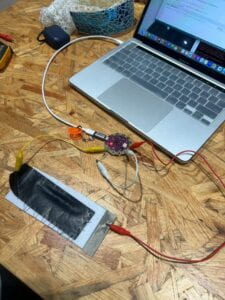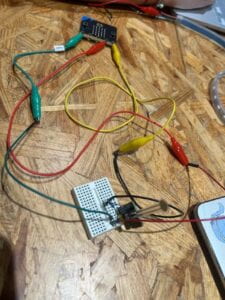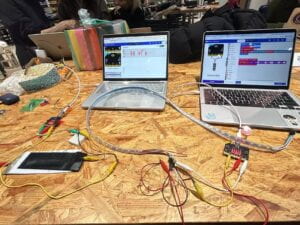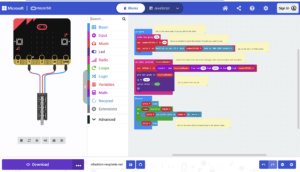Here is the video of the final output
EXERCISE 1: LILYPAD

CONNECT THE SENSOR TO THE LILYPAD
Problems that occurred in this exercise were the bad connection due to problems with the wires. One solution was to use as few wires as possible and wrap the resistor directly on Lilypad.
Above is the video for connecting the neopixels to the lilypad and the functioning output.
Exercise 2
1. Setting up the sensor and the first micro:bit

Video:
2. Programming the second micro:bit to receive values and use them to control the neopixels.

Code:

First is the link to the Original video, with the problem of blinking too fast.
Here is the link to the video of the final functioning output
Arduino Code:
#include <Adafruit_NeoPixel.h> #include <Adafruit_NeoPixel.h> // ixfashion week 3 #include <Adafruit_NeoPixel.h> // Which pin on the Arduino is connected to the NeoPixels? #define PIN 3 // How many NeoPixels are attached to the Arduino? #define NUMPIXELS 60 // When setting up the NeoPixel library, we tell it how many pixels, // and which pin to use to send signals. Note that for older NeoPixel // strips you might need to change the third parameter -- see the // strandtest example for more information on possible values. Adafruit_NeoPixel pixels(NUMPIXELS, PIN); // analog sensor int sensorPin = A3; void setup() { // initialize serial communication at 9600 bits per second: Serial.begin(9600); // INITIALIZE NeoPixel strip object (REQUIRED) pixels.begin(); } void loop() { //read the sensor value int sensorValue = analogRead(sensorPin); //map the values int ledsOn = map(sensorValue, 0, 470, 1, NUMPIXELS); pixels.clear(); // Set all pixel colors to 'off' //turn on a number of LEDs on according to the values from the sensor for(int i = 0; i < ledsOn; i++){ pixels.setPixelColor(i, pixels.Color(255, 255, 255)); pixels.show(); // Send the updated pixel colors to the hardware. } Serial.println(sensorValue); } Question: Investigate how animals/plants communicate with each other and write about an interesting form of communication that you could use in a wearable to communicate with others. By reading the materials given, I learned that plants and animals could communicate in many ways that I wasn't aware of. Only visual signals already included many types of language including facial expressions, color-change, gaze-following, etc. I find many signals that can be explored and achieved through microcontrollers in wearables. Inspired by the way certain animals and plants change color or light through chemical reactions, the wearable could feature responsive fabrics or materials that change color or light in response to environmental factors or user input.For example, I can explore temperature-sensitive materials or sensors that can change color or the color of the LEDs based on the wearer's body temperature. The change of the LEDs or Neopixels can also result from the change in pressure, speed, etc. Other interesting communication forms Drawing from the concept of gaze-following behavior observed in animals, the wearable could feature embedded sensors or cameras that track the wearer's gaze direction. This information could be used to trigger interactive responses within the device or to communicate with external devices or systems. An example is Caress of the Gaze by Behnaz Farahi
Another interesting form is to explore bio-inspired sound communication. The wearable could contain small speakers, actuators, or motors that emit sounds mimicking those of animals or natural environments. Users could control these sounds through gestures or voice commands. These communication forms inspired my idea of making wearables incorporating rubbing specialized body parts together and vibration to produce sounds like arthropods. I often encounter situations when I don't want to open my mouth to speak a word but want to convey the message of rejection or happiness. Previously these were shown by my eyes, but I want to explore how they can be conveyed through the frictions of different fabrics and motors. For example, motors can be connected to fabric and when feel pressure detected by pressure sensor or heartrate sensor, the motor will lead the fabric to move and produce sound. Adding color and light signals to these is also preferrable. How do you imagine you could use what you learned today for a wearable? To incorporate sensors into wearables, I learned today that controlling the sensors through radio communication using micro:bit can enable wireless connections when I have wearables that interact with each other. For example, if I want to integrate neopixel strips on the wearables and want them to change color based on temperature sensors, the neopixel strips won't have to be connected to the breadboard or lily pad. Each wearable could be equipped with temperature sensors to detect changes in the wearer's environment. With the micro:bit's radio communication capabilities, these wearables could exchange real-time temperature data. Furthermore, by eliminating the need for physical connections between the wearables and the sensors, the design becomes more streamlined and user-friendly. The wireless connection can make the whole interactive mechanism more convenient for wearers.